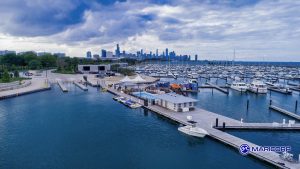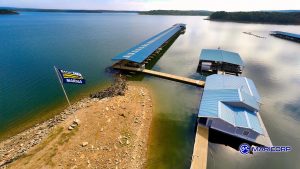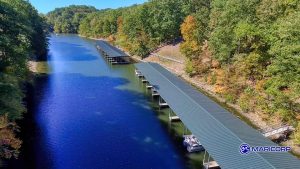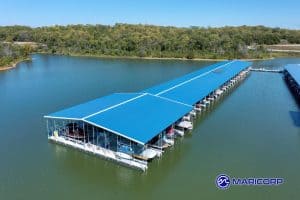Child Passenger Safety Awareness Week 2025
Child Boating Safety Deserves the Spotlight This September
Every September, the National Highway Traffic Safety Administration (NHTSA) launches Child Passenger Safety Awareness Week, an annual observance aimed at educating parents and guardians on the importance of properly securing children in vehicles. But for marina communities, this week offers a valuable opportunity to shift the conversation to a parallel concern: child boating safety.
While most parents are vigilant about car seats and seat belts, boating often falls into the “recreational” category of thinking, fun focused, more relaxed, and sometimes less structured when it comes to child safety. Yet, the risks associated with bringing young passengers aboard a boat are just as serious, and in some cases, more so. Docks, boats, and open water environments are inherently unpredictable, and without the proper safeguards, children can be vulnerable to accidents that are easily preventable.
Making It a Marina Priority
For marinas and boatyards that regularly host families, September is more than just the start of the fall transition, it’s a chance to reinforce smart habits and reintroduce safety initiatives before seasonal traffic begins to wind down. Hosting or promoting child boating safety resources during this national week can demonstrate a marina’s commitment to community welfare, especially for returning renters and seasonal guests who bring children aboard.
While many marinas already post basic rules, like no running on docks or life jackets required on children under 12, Child Passenger Safety Awareness Week provides a fresh reason to revisit those standards and educate guests. Messaging doesn’t have to be overbearing. A few strategically placed signs, a newsletter mention, or a small weekend event (even a coloring contest with a safety theme) can go a long way in reinforcing positive behavior and increasing overall vigilance.
Unique Risks for Young Passengers
Children, especially those under the age of 8, experience boating differently than adults. Their balance is less developed, their reaction time slower, and their ability to recognize and assess danger minimal. Something as routine as boarding a boat can be hazardous if a child slips between the dock and gunwale or loses footing on a wet surface. Even in calm waters, kids can be knocked off balance by a wave, a quick turn of the helm, or shifting gear onboard.
And while adults may be comfortable moving freely around the vessel, children need boundaries. Boats don’t come with child locks, seat belts, or air bags, once the dock lines are off, the only thing keeping a young passenger safe is preparation.
That’s why child boating safety deserves equal attention to its automotive counterpart. It’s not enough to clip on a life vest and hope for the best. Adults must take an active role in modeling behavior, conducting predeparture safety checks, and teaching kids how to move, sit, and respond to instructions aboard any vessel.
September Is the Right Time
Many families take one final trip over Labor Day weekend or early September before school schedules take over. That final outing can either be a cherished memory, or, a dangerous one. Late season boating often means fewer staff on duty, shorter daylight hours, and cooler water temperatures, factors that elevate risk if something goes wrong.
By aligning child boating safety messaging with Child Passenger Safety Awareness Week, marinas can use this quiet seasonal window to highlight family first practices while helping ensure kids are protected during the tail end of the boating season. Not only does it serve an important purpose, but it also reinforces a marina’s image as a safety conscious, family friendly place to return next year.
Practical Ways Marinas Can Promote Child Boating Safety
When it comes to fostering a safety first marina culture, signage and staff training are only the beginning. During Child Passenger Safety Awareness Week, marinas have an excellent opportunity to be proactive, not just reactive, by creating simple, family focused engagement that reinforces smart boating habits in a fun, visible way.
Use Signage That Speaks to Families
Standard safety signs often get tuned out, especially when they’re overly technical or cluttered. Consider refreshing any existing notices with concise, kid friendly language and visuals. A sign that reads “All children must wear a life jacket” is more effective when paired with a bright image or mascot. Marinas could also add location specific reminders at entry ramps, docks, and fuel areas like:
- “Watch your step – little feet slip fast!”
- “Hold hands near the edge.”
- “Life jackets before liftoff!”
Temporary signage during the week of September 21–27 can help refocus attention and encourage adults to reinforce these reminders with their children.
Host a Marina Safety Pop-Up or Info Table
If your marina typically sees weekend traffic in late September, set up a small pop-up booth or tabletop display near the harbor office, ship’s store, or launch ramp. Offer brochures from the U.S. Coast Guard or local water patrol about life jacket sizing, age specific boating rules, or safe navigation with kids aboard. Some marinas even invite a local fire department or search and rescue team to engage families with a short safety demo or Q&A.
You don’t need to host a large event. Just being present and offering a space for parents to ask questions, pick up resources, or grab child sized whistles and ID tags can leave a lasting impression.
Get Social: Raise Awareness Online
Promote Child Passenger Safety Awareness Week on your marina’s social media channels and email newsletters. A few timely posts with photos of children properly outfitted in life vests (with parental consent, of course) can spread the message while showcasing your marina as a family minded location. Suggested post themes include:
- “Top 5 safety tips for boating with kids”
- “How to fit a child’s life jacket properly”
- “Why fall boating still requires extra caution for families”
A downloadable PDF checklist for parents (covering what to pack, rules to review, and boat prep steps) can also serve as a value-added resource, encouraging shares and engagement while positioning the marina as a trusted guide.
Train Staff on Kid-Specific Protocols
Even if your marina staff is well versed in general emergency procedures, it’s worth reviewing how to handle child specific scenarios, such as a missing child on the dock, a life vest that doesn’t fit properly, or a panicked parent. A short pre-weekend briefing during Child Passenger Safety Awareness Week can include:
- Age-appropriate life jacket requirements (federal and state specific)
- How to approach parents about unsafe behavior diplomatically
- Who to contact if a child falls in or goes missing
- Locations of extra child-size PFDs (if available)
Involving dockhands and fuel dock staff ensures consistency across all marina touchpoints and reinforces a unified message to guests.
Encourage Early Habits
For families with very young children, boating safety often starts with exposure and repetition. Offering a “junior boater badge,” free coloring page, or scavenger hunt during the week can help build those early associations. When a child feels that boating and safety go hand in hand, they’re more likely to cooperate when it counts.
Even a small incentive, a sticker, pencil, or certificate, can go a long way toward fostering compliance and enthusiasm, while giving the marina a community-minded image that parents appreciate.
Must Have Gear and Cold Season Prep for Child Boating Safety
As the weather begins to shift in September, so do the safety considerations for boating families. Air and water temperatures begin to drop, daylight hours shorten, and fewer boats are out on the water to assist in an emergency. That makes it even more important for marinas and boaters alike to be fully prepared, especially when young passengers are involved.
Check the Life Jacket—Then Check It Again
By federal law, children under 13 must wear a U.S. Coast Guard approved life jacket while aboard a moving vessel, unless they are below deck or within an enclosed cabin. But that rule is just the baseline. A poorly fitting or improperly worn PFD can render the regulation meaningless in an emergency.
To ensure proper protection:
- Size Matters: Life jackets are sized by weight and chest size. If a child has outgrown last year’s gear, it’s time to size up.
- Strap Check: All buckles and straps should be fastened snugly. The jacket should not ride up above the chin or ears when pulled at the shoulders.
- Try It in Water: If possible, let the child try the life jacket in shallow water under supervision. They should float comfortably with their head clear and be able to move their arms freely.
Marinas can help by carrying or recommending child-specific PFDs at their retail locations or having a few available on loan for renters who show up unprepared. Even displaying a sample life jacket fitting chart near the marina store or dockhouse can make a difference.
Layering for Late Season Comfort and Safety
In cooler conditions, children can become chilled quickly, even if they never fall in. Cold air and damp breezes can set in once the sun drops, particularly on inland lakes and rivers. If a child is cold or wet, their ability to follow instructions, stay alert, and respond to emergencies diminishes.
Encourage families to:
- Dress kids in quick drying base layers and windproof outer layers
- Pack a change of clothes in a waterproof bag
- Use hats and light gloves for evening outings or breezy conditions
- Choose closed toe shoes with good grip for traction on wet decks
Remind parents that bulky clothing can interfere with how a life jacket fits. They may need to adjust sizing or remove a thick hoodie to allow the PFD to function properly.
Emergency Prep for Family Boating
Every boat should carry basic safety equipment, but when kids are on board, the gear needs to support a faster response and simpler communication. Parents and guardians should be advised to:
- Show children where the emergency whistle is stored
- Point out the throwable flotation device and demonstrate its use
- Assign a designated watcher, an adult tasked with monitoring the kids at all times
- Discuss a simple overboard plan, including what the child should do and say if they fall in or see someone else in trouble
It’s also smart to recommend that families carry a photo ID and medical info for each child on board. In case of separation or emergency medical treatment, this information can be critical.
Cold Water Risks: A Hidden Danger
September may still bring warm afternoons, but water temperatures can drop quickly, especially in large reservoirs or northern lakes. Immersion in cold water can cause shock, disorientation, and rapid incapacitation, even in strong swimmers.
Young children are at particular risk because of their smaller body mass and reduced ability to generate heat. A fall into cold water without immediate retrieval could be fatal, even with a life jacket.
That’s why fall boating trips with kids should be:
- Shorter in duration
- Closer to shore
- Avoidant of rough or remote waters
Marinas can help educate guests by posting or sharing weekly water temperature ranges and offering guidance on suitable destinations for family outings.
Don’t Forget the Dockside Safety Check
Some of the most preventable child injuries occur not on the water, but right at the dock. Worn cleats, loose boards, and trip hazards can spell danger for tiny feet and distracted parents. Even a missed handhold while stepping aboard can lead to slips, twisted ankles, or worse.
Before each fall weekend, marina staff should inspect:
- Dock edge markings
- Loose boards or hardware
- Handrails or ladders for wear and accessibility
- Fuel and water hoses that could become entangled underfoot
Encouraging families to slow down, supervise closely, and keep children near adults while transitioning on and off the boat should be part of every departure and arrival routine.
Additional Safety Related Articles:
- Operational Marina Safety Planning
- Springtime Boat Safety Checklist
- Choosing a Life Jacket – the First Step to Boating Safety
- 5 Marina Safety Programs & Tips
- National Safe Boating Week
- Dos and Donts of Boating with Pets
- Electric Shock Drowning Prevention Tools
- Marina Installs ESD Prevention Tool
- Importance of Life Jacket Inspection and Maintenance
- Hurricane Preparedness Plans and Preparation
- What is a Personal Location Beacon?
- Emergency Position Indicating Radio Beacon Maintenance
- Boat Fire Takeaways for a Safer Marina
- Pet Heat Safety Guide for Marinas
- Dock Lifeguard Systems ESD Prevention
*Sign up for our free newsletter “Marina Management Journal” so you can stay up to date
About MariCorp
Maricorp is one of the largest floating boat dock manufacturing and construction companies in the United States, specializing in galvanized steel floating docks and boat lift systems. With projects spanning coast-to-coast, Maricorp provides marina consultation and design, marine construction, marina repair and renovation, and boat dock disaster response and demolition.














